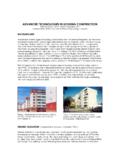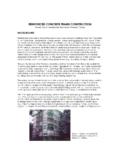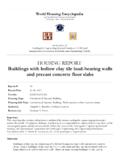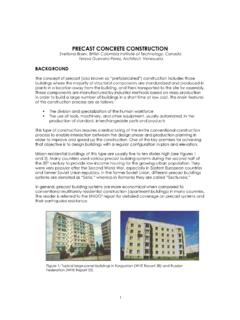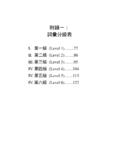Transcription of TIMBER CONSTRUCTION - World Housing Encyclopedia
1 TIMBER CONSTRUCTIONC hris Arnold, Building Systems Development, USABACKGROUNDWood CONSTRUCTION is common for many single-family houses throughout the World . In areas where TIMBER and wood materials are easily accessible, wood CONSTRUCTION is often considered to be the cheapest and best approach for small Housing main types of wood CONSTRUCTION are listed in the Encyclopedia . These types use all forms of TIMBER available from logs to sawn/shaped timbers to smaller branches and leaves. These types also utilize various types of wall coverings from plant-based coverings to TIMBER materials to earthen materials, such as mud or stone. The first type of wood CONSTRUCTION is thatch CONSTRUCTION , which is generally a traditional CONSTRUCTION type. For examples of this type, see the traditional CONSTRUCTION section of the Encyclopedia . Other types include post-and-beam frame CONSTRUCTION , walls with bamboo/reed mesh and post (waffle and daub), wooden frames with or without infill, and stud-wall frames with plywood/gypsum board sheathing.
2 Two final types are wood panel CONSTRUCTION and log some of the main types of wood CONSTRUCTION are discussed in detail in the Encyclopedia . The first of these CONSTRUCTION types is stud-wall frame with plywood/gypsum board sheathing (Figure 1), which is popular worldwide and is the main type used in the United States (WHE Report 90), Canada (WHE Report 82), and Japan (WHE Report 86). For this type, walls are made of vertical TIMBER elements of rectangular cross-section covered in light plywood or composite sheathing, with roofs made of TIMBER members or prefabricated trusses, which are sheathed similar to the walls. The building foundations are usually concrete but sometimes are made of stone. In Japan, a post-and-beam frame is also constructed. It is similar to the stud-wall frame, except that it uses diagonal members to create its shear walls instead of sheathing. Horizontal TIMBER CONSTRUCTION (Figure 2) is found in parts of the Russian Federation, particularly in rural forested areas (WHE Report 56, Russian Federation).
3 For this system, walls are made of horizontal sawn TIMBER logs of square or circular cross-section joined without mechanical fasteners at the corners. The buildings have TIMBER roofs and stone or concrete foundations. The final system of CONSTRUCTION reviewed in the Encyclopedia is wood panel CONSTRUCTION (WHE Report 57, Russian Federation). This is typically found in the Russian Federation where its prefabricated panels are easily constructed for government low-income Housing (Figure 3). Walls and floors are made of layered wood members with TIMBER roofs and concrete : Typical two-story house in Canada (WHE Report 82)Figure 2: Typical log house in the Russian Federation (WHE Report 56)Figure 3: Typical wood panel house in the Russian Federation (WHE Report 57)2 TIMBER ConstructionWOOD FRAME CONSTRUCTIONA typical modern wood-frame house consists of a reinforced concrete strip-footing foundation, whereupon a platform is constructed of joists covered with plywood or oriented strand board (OSB) to form the ground-floor level of the house (also known as platform wood-frame CONSTRUCTION ).
4 This platform is connected directly to the foundation with anchor bolts. On this base, the exterior and interior walls are erected. The walls consist of a horizontal sill plate with vertical TIMBER studs with board or panel sheathing nailed to the studs on the outside of the building (Figure 4). After the first-story walls are completed, the second-story floor is constructed, which, in turn, acts as a platform for erection of the second-story walls. This process is continued for all the stories. The roof structure typically consists of prefabricated trusses, which are covered with sheathing and roof tiles (Rainer and Karacabeyli 2000).The standardized wood-frame structure of today is now augmented by a wide range of compatible standardized components, such as doors, windows, electrical and plumbing fixtures, and the like, which are designed to be easily installed in the wood structure. Because wood-frame walls are hollow, alternative levels of insulation can be installed enabling any climatic conditions to be accommodated.
5 Plumbing, heating, and electrical services are easily installed within the walls, in the open spaces above ceilings, within the floor structure, and in the space between the first (ground) floor and the ground below. Wood-frame houses can be up to three stories in height, as per typical code limits. The vast majority of residences in the USA, Japan, and Canada are wood-frame CONSTRUCTION , as described above. Canadian one-story residences are often non-engineered constructions, which differ from the USA, Japan, and the Russian Federation s government Housing , where residences are engineered by an architect. Sill Plate Method Used in Platform ConstructionFigure 4: Platform CONSTRUCTION detail in Canada (WHE Report 82)Figure 5: Typical first-floor plan for wood-frame house in California, USA (WHE Report 90) TIMBER Construction3 USE AND COST Today, wood frame is used for approximately 90% of the houses constructed in the USA, predominantly in suburban regions.
6 Costs vary greatly by region and house design, and range from about 650 US$/m2 to 2200 US$/m2 (WHE Report 90, USA), excluding land cost. The cost for a single-family residential house in Japan ranges from 1100 US$/m2 to 2800 US$/m2 (WHE Report 86, Japan).STRUCTURAL SYSTEMIn the typical wood frame house, gravity loads are accommodated by wood studs, commonly placed at 16 inches (approximately 400 mm) centers. Floor and roof-framing members are commonly 2 inches (50 mm) in thickness and may be from 6 to 14 inches (150 mm to 350 mm) in depth. Lateral resistance is provided by a shear-wall system consisting of plywood or manufactured wood panels (particle board) nailed to vertical studs, creating shear walls (Figures 6 and 7). Today s wood frame CONSTRUCTION is highly codified and regulated in the USA (WHE Report 90, USA), with a generally good standard of inspection by suburban local building departments in earthquake -prone regions.
7 In smaller towns and rural areas, quality control may be 7: Typical one-story wood-frame CONSTRUCTION (WHE Report 90)Figure 6: Installation of prebuilt stud wall on reinforced concrete floor slab (WHE Report 90)Japanese wooden Housing is built using post-and-beam CONSTRUCTION (WHE Report 86, Japan), similar to the CONSTRUCTION in the USA and Canada. Wooden posts, with cross-sectional dimensions ranging from 05 mm to 50 mm, carry gravity loads. The roof structure is made out of wood and is covered by roof tile or slate. The roof load is transferred to the wood frame. The roof-supporting system in Japan is different from that of western countries and is based only on vertical and horizontal members. No diagonal members or trusses are used, as is common for similar CONSTRUCTION in Western countries. For most TIMBER structures in Japan, Canada, and the USA, the lateral load resistance is provided by wooden shear walls with plywood or manufactured wood panels ( particle board ) nailed to the vertical wooden members.
8 The building code generally regulates the number and dimensions of shear walls. In Japan (WHE Report 86), another common approach to shear-wall CONSTRUCTION is a wooden wall with interior diagonal brace 4 TIMBER Constructionmembers (Figure 8). However, the traditional Japanese house did not have a diagonal brace. A thin lumber running through posts, called Nageshi, and a thick wood post provided lateral resistance. Japanese CONSTRUCTION also often uses metal joints, and in recent wooden Housing , plates are used to stiffen the wood frame. Alternate approaches to the post-and-beam CONSTRUCTION are the Russian Federation s TIMBER panel CONSTRUCTION and horizontal TIMBER log CONSTRUCTION (WHE Report 56, WHE Report 57, Russian Federation). The panel buildings use load-bearing panel walls to carry gravity loads. The layered paneling acts as a shear wall to resist lateral loads. These layered TIMBER panels also serve as floor and roof diaphragms.
9 The horizontal TIMBER system uses stacked logs as vertical and lateral load-resisting elements (Figure 9). The horizontal logs are joined by hand-sawn connections without mechanical fasteners (Figure 10).Figure 8: Post-and-beam CONSTRUCTION in Japan with diagonal bracing (WHE Report 86)Figure 9: Section of horizontal log house wall CONSTRUCTION in the Russian Federation (WHE Report 56)Figure 0: Detail of wood connections in log house CONSTRUCTION (WHE Report 56)SEISMIC PERFORMANCEThe seismic resistance of wood-frame structures is relatively high, provided the quality of materials and the CONSTRUCTION are satisfactory. The buildings generally tend to be lightweight, especially when compared to brick or stone, which helps reduce earthquake forces on the structures. In addition, because of the relatively large number of walls and the use of numerous nailed connections, wood-frame houses have traditionally performed well in earthquakes so that deaths and serious injuries are rare.
10 The seismic performance of wood-frame CONSTRUCTION is greatly enhanced by its non-structural components (WHE Report 82, Canada). The architectural finishes and numerous non-load-bearing walls increase the amount of energy the building can dissipate during an earthquake because these additional systems absorb energy as they are damaged. Finishes, such as stucco that are used in the USA, Canada, and Japan, crack and spall, which adds additional earthquake resistance to buildings; therefore, a TIMBER Construction5 Figure : A photograph illustrating typical earthquake damage from the1958 Kamchatka earthquake (WHE Report 56)typical wood frame house is usually considered to have medium-to-low vulnerability to earthquakes. Horizontal TIMBER buildings in the Russian Federation have performed moderately well in past earthquakes (Figure 11). Panel buildings in the Russian Federation have yet to experience large earthquakes.
